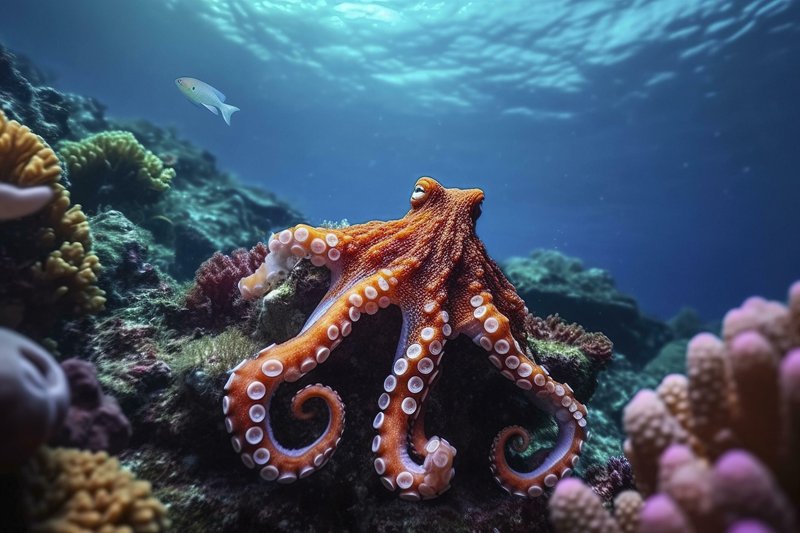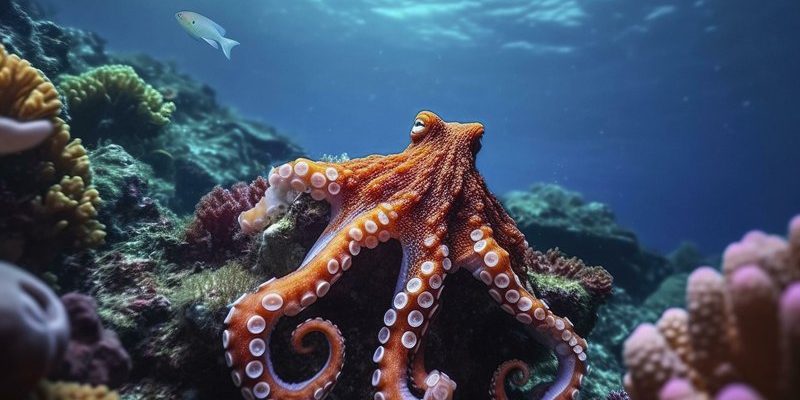
You might be surprised to learn that despite its size—it can weigh up to 110 pounds and grow to nearly 20 feet long—the Giant Pacific Octopus is a master of disguise and flexibility. Its adaptations are like a Swiss Army knife; each feature serves a specific purpose to help it navigate challenges in the underwater realm. From expert camouflage to impressive intelligence, this octopus proves that survival in the wild is an art—and it’s an artist extraordinaire.
1. Camouflage: A Master of Disguise
One of the most striking adaptations of the Giant Pacific Octopus is its ability to blend seamlessly into its environment. Think of it like wearing an invisibility cloak! This octopus has specialized skin cells known as chromatophores, which contain pigments. By expanding or contracting these cells, it can change its color and texture in an instant.
Let me explain further. Imagine you’re at a costume party. If you wear a costume that mimics the room’s decor, people might just overlook you. The octopus does something similar. When it spots a potential predator or prey, it can adapt in seconds to match the rocky seabed or the vibrant coral. This not only keeps the octopus safe from danger but also makes it a stealthy hunter.
Additionally, it can mimic the texture of its surroundings. So, if it’s near a rough coral reef, it can adjust its skin to appear bumpy and rugged. This dual ability to change color and texture is like being able to change your outfit and hairstyle at the same time to fit in perfectly!
2. Intelligence: The Brainy Cephalopod
The Giant Pacific Octopus isn’t just about looks; it’s also incredibly smart. In fact, it’s one of the most intelligent invertebrates on the planet. You might be wondering how that even works. Well, it has a complex nervous system and a brain that allows it to solve problems, navigate mazes, and even use tools. Yes, tools!
For instance, some octopuses have been observed using coconut shells and seashells as shields or even homes. Imagine a creature crafting its own armor! This level of problem-solving shows that the Giant Pacific Octopus is not only aware of its surroundings but also knows how to manipulate them for its benefit.
When you think about intelligence in animals, you might consider dogs or dolphins. But here’s the thing—octopuses have a different kind of intelligence. They’re solitary animals that rely on their wit and quick thinking to survive. They can learn from experience, adapt to new situations, and even escape from tricky situations, which is nothing short of fascinating.
3. Arm Flexibility and Dexterity
Now, let’s talk about the octopus’s arms. With eight long, flexible arms, the Giant Pacific Octopus can do things that would leave most animals scratching their heads. Each arm can move independently, allowing for incredible dexterity. Picture a magician performing sleight of hand; that’s how skillfully these arms can maneuver.
Each arm is lined with thousands of sensitive suckers that can feel and grip. This means the octopus can taste and touch simultaneously, giving it a rich sensory experience of its environment. It’s like having a hand that can explore the ocean floor while also grabbing dinner!
Moreover, the octopus can squeeze its body through tight openings thanks to its lack of a rigid skeleton. This ability to contort itself allows it not just to escape predators but also to find shelter in the nooks and crannies of rocky reefs. It’s a real-life escape artist!
4. Ink Defense Mechanism
When faced with danger, the Giant Pacific Octopus has one last trick up its sleeve—its ink. This isn’t just any ink; it’s a clever defense mechanism. When threatened, the octopus can release a cloud of dark, inky fluid, obscuring its predator’s view. It’s like throwing a smoke bomb!
This ink not only provides cover but also contains chemicals that can dull the sense of smell in other animals. So while a predator is busy figuring out what just happened, the octopus can slip away to safety.
Interestingly, this ink can also serve another purpose. Some researchers believe it might confuse predators or even attract other animals that would eat the predator. It’s a fascinating example of how this creature turns the tables in its favor.
5. Specialized Feeding Habits
Feeding is another area where the Giant Pacific Octopus excels with its unique adaptations. Its diet primarily consists of crustaceans, fish, and even other octopuses. To catch these meals, it uses a combination of tactics that highlight its intelligence and dexterity.
One method involves using its strong, beak-like mouth to crack open shells. Think of it as using a nutcracker. This allows the octopus to access the tender meat inside. Moreover, it uses its arms to search crevices and holes for hiding prey, showcasing its incredible problem-solving skills.
Another fascinating aspect of its feeding habits is how it can store food. If it catches more than it can eat at once, it often hides its prey in rock crevices or under rocks for later. This kind of foresight is a clear indicator of the octopus’s intelligence—almost like planning for a rainy day.
6. Adaptations to Habitat
The Giant Pacific Octopus thrives in various underwater habitats, from deep ocean floors to rocky shorelines. One of its most remarkable adaptations is its ability to adjust to different environments. It can be found at depths ranging from shallow tide pools to dark ocean depths of over 3,000 feet.
In each of these habitats, the octopus makes small adjustments to its behavior and physical traits. For instance, in rocky areas, it might camouflage better against rocks, while in sandy areas, it might bury itself to avoid detection. This adaptability is key to its survival, allowing it to occupy diverse environments where food sources and threats vary.
This ability to thrive in various conditions is similar to how some people can adapt to different social settings. Whether at work, home, or among friends, being able to adjust to your surroundings can lead to success. For the octopus, this flexibility is crucial for navigating the challenges of ocean life.
7. Reproductive Adaptations
Finally, let’s talk about reproduction. The Giant Pacific Octopus has some intriguing adaptations when it comes to ensuring the next generation. After mating, the female lays thousands of eggs, often in a safe, secluded spot like a rocky den.
But here’s where it gets fascinating—after laying her eggs, the female tends to them diligently, but at a cost. She stops eating and spends the remainder of her days guarding the eggs, ensuring they receive oxygenated water by gently blowing water over them with her arms. This intense focus means she sacrifices her health for her offspring.
Once the eggs hatch, the female octopus dies shortly after. This selfless act is nature’s way of ensuring that her energy is directed toward the survival of her young. Though it might seem tragic, it highlights the incredible adaptations of the Giant Pacific Octopus—every aspect of its life, from survival to reproduction, is finely tuned to thrive in the underwater world.
The Giant Pacific Octopus is an extraordinary creature, showcasing a range of adaptations that allow it to flourish in the vast ocean. From its incredible camouflage and intelligence to its unique feeding habits and reproductive strategies, each feature plays a vital role in its survival. It’s a reminder of how life can adapt in intricate ways to meet the challenges of the environment.
Next time you think about the wonders of the ocean, remember the Giant Pacific Octopus. With its blend of beauty and ingenuity, it’s a true testament to the power of adaptation in the animal kingdom. Whether it’s evading predators or hunting for the next meal, this remarkable octopus continues to captivate and inspire anyone who ventures into its underwater world.

